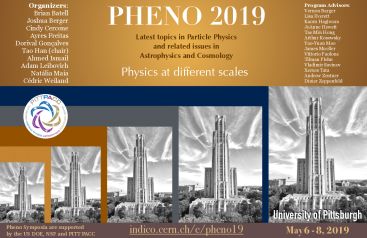Conveners
Flavor II
- Vladimir Savinov (University of Pittsburgh)
Recently LHCb announced the exciting discovery of direct CP asymmetry in D0 decays to K-pairs and pion pairs around 15X10^-4. It is extremely difficult to do reliable calculations for the expectations from the SM for these asymmetries because of large non-perturbative effects. However, a mechanism will be proposed to helps us understand roughly the size of the asymmetry and the key idea...
One of the conditions for creating a matter-dominated Universe is presence of interactions that differentiate between matter and anti-matter. Properties of such interactions can be probed at particle accelerators by studying decay patters of produced particles. On March 21, one of the CERN's experiments, the LHCb, announced observation of CP-violation in the decays of particles containing...
We develop a systematic treatment of the heavy-flavor hadroproduction in general-mass variable flavor number scheme (GM-VFNS). By following the idea of Simplified-ACOT-?chi scheme in the deep inelastic scattering (DIS), we categorize the open heavy-flavor diagrams into Flavor Excitation (FE) and Flavor Creation (FC). The overlapped diagrams are subtracted by the collinear splitting in order to...
Recent results of the LHCb experiment related to b&c hadron spectroscopy including exotic hadron states.
Doubly heavy baryons and singly heavy antimesons are related by heavy quark-diquark (HQDQ) symmetry because in the $m_Q \to \infty$ limit the light degrees of freedom in both hadrons are expected to be in identical configurations. Hyperfine splittings of the ground states in both systems are nonvanishing at $O(1/m_Q)$ in the heavy quark mass expansion and HQDQ symmetry relates the hyperfine...
If the $X(3872)$ is a weakly bound charm-meson molecule, it can be produced in $e^+ e^-$ annihilation by the creation of $D^{*0} \bar D^{*0}$ from a virtual photon followed by the rescattering of the charm-meson pair into the $X$ and a photon. A triangle singularity produces a narrow peak in the cross section for $e^+ e^- \to X \gamma$ about 2.2 MeV above the $D^{*0} \bar{D}^{*0}$ threshold....
The rare inclusive decay $\bar{B}\rightarrow X_s\gamma$ is an important probe of physics beyond the standard model. The largest uncertainty on the decay rate and CP asymmetry comes from resolved photon contributions. They first appear at order $1/m_b$ in the heavy quark expansion and arise from operators other than $Q_{7\gamma}$. One of the three leading contributions in the heavy quark...
